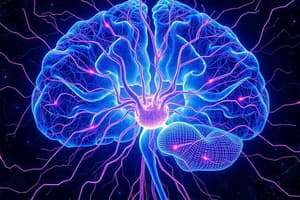Podcast
Questions and Answers
Which part of the brain is responsible for higher cognitive functions such as reasoning and problem-solving?
Which part of the brain is responsible for higher cognitive functions such as reasoning and problem-solving?
- Cerebellum
- Cerebrum (correct)
- Brainstem
- Spinal Cord
What is the main function of the cerebellum?
What is the main function of the cerebellum?
- Consciousness regulation
- Motor coordination (correct)
- Memory storage
- Blood pressure control
Which region of the central nervous system connects the cerebrum, cerebellum, and spinal cord?
Which region of the central nervous system connects the cerebrum, cerebellum, and spinal cord?
- Brainstem (correct)
- Cerebellum
- Peripheral Nervous System
- Cerebrum
What is the primary center for processing, integrating, and storing information in the nervous system?
What is the primary center for processing, integrating, and storing information in the nervous system?
Which part of the brain is responsible for overseeing essential functions like breathing and blood pressure regulation?
Which part of the brain is responsible for overseeing essential functions like breathing and blood pressure regulation?
What is the main function of the spinal cord?
What is the main function of the spinal cord?
Which type of pathways transmit sensory information to the brain?
Which type of pathways transmit sensory information to the brain?
What are reflexes?
What are reflexes?
What challenges do researchers face in studying the CNS?
What challenges do researchers face in studying the CNS?
What do advancements in neuroimaging techniques like fMRI allow researchers to study?
What do advancements in neuroimaging techniques like fMRI allow researchers to study?
Flashcards are hidden until you start studying
Study Notes
The Nervous System: A Complex Network of Communication
The nervous system, a vital component of our organism, is responsible for processing information and transmitting signals that enable us to experience, learn, and adapt to our environment. This extensive network can be divided into two primary systems: the central nervous system (CNS) and the peripheral nervous system (PNS). In this article, we will focus on the central nervous system, a complex and intricate system that encompasses the brain and spinal cord.
The Central Nervous System (CNS)
The CNS, consisting of the brain and spinal cord, is the primary center for processing, integrating, and storing information. This system is responsible for higher functions such as memory, thinking, and decision-making.
The brain can be divided into several regions, each with distinct functions:
-
Cerebrum: The largest part of the brain, responsible for higher cognitive functions such as reasoning, problem-solving, and learning. The cerebrum is further divided into two hemispheres, left and right, which work together to carry out complex tasks.
-
Cerebellum: Located at the base of the brain, the cerebellum plays a crucial role in motor coordination, maintaining posture, and maintaining balance.
-
Brainstem: This region connects the cerebrum, cerebellum, and spinal cord. The brainstem oversees essential functions such as breathing, blood pressure regulation, and consciousness.
The spinal cord, a cylindrical structure located within the vertebral column, serves as a connection between the brain and the rest of the body. It relays sensory information to the brain and sends motor signals back to the body.
Organization of the CNS
The CNS is organized into distinct pathways and neural circuits that facilitate communication and information processing.
-
Afferent pathways: These pathways transmit sensory information to the brain. Sensory information is conveyed through specialized nerve cells called sensory neurons, which transmit the information via sensory receptors (such as those in the skin, muscles, and organs) to the CNS.
-
Efferent pathways: These pathways transmit motor signals from the brain to the muscles and glands. Motor neurons, which originate in the brain or the spinal cord, send signals to the effector organs (muscles and glands) to initiate movement and other responses.
-
Reflexes: Reflexes are involuntary, rapid responses to stimuli. They are mediated by reflex arcs, which are simple, direct connections between sensory receptors, interneurons, and motor neurons. Reflexes are crucial for maintaining homeostasis and protecting the body from harm.
Challenges and Continuing Research
Despite its complexity, the CNS continues to be an area of intense research. Challenges include understanding the intricate connections between neurons, the role of glial cells in supporting neuronal function, and the mechanisms underlying neuroplasticity (the ability of the brain to adapt and reorganize itself).
In recent years, advancements in neuroimaging techniques (such as functional magnetic resonance imaging or fMRI) have provided valuable insights into the workings of the CNS. These methods allow researchers to study the brain's activity during various tasks, such as memory formation, decision-making, and sensory processing.
In conclusion, the central nervous system is a remarkable and intricate network that enables us to experience and interact with our world. The CNS's organization, connectivity, and complexity have captivated and challenged researchers for centuries. As our understanding of the CNS deepens, we can anticipate continued advancements in the field of neuroscience, which will undoubtedly benefit society as a whole.
Studying That Suits You
Use AI to generate personalized quizzes and flashcards to suit your learning preferences.




